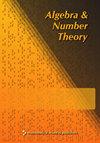切线可展面与K3地毯的切线可展面协同作用
IF 1
1区 数学
Q2 MATHEMATICS
引用次数: 0
摘要
给出了Aprodu、Farkas、Papadima、Raicu和Weyman关于有理法向曲线切线可展曲面合边定理的简单几何证明,以及Raicu和Sam关于K3地毯合边定理的简单几何证明。因此,我们在代数闭域k上,当char (k)= 0或char (k)≥⌊(g−1)∕2⌋时,得到了g属一般曲线的格林猜想的一个快速证明。我们的方法为研究切线可展曲面提供了一种新的方法。同时,给出了任意大次光滑投影曲线的切可展曲面的算术正态性。本文章由计算机程序翻译,如有差异,请以英文原文为准。
Syzygies of tangent-developable surfaces and K3 carpets via secant varieties
We give simple geometric proofs of Aprodu, Farkas, Papadima, Raicu and Weyman’s theorem on syzygies of tangent-developable surfaces of rational normal curves and Raicu and Sam’s result on syzygies of K3 carpets. As a consequence, we obtain a quick proof of Green’s conjecture for general curves of genus over an algebraically closed field with or . Our approach provides a new way to study tangent-developable surfaces in general. Along the way, we show the arithmetic normality of tangent-developable surfaces of arbitrary smooth projective curves of large degree.
求助全文
通过发布文献求助,成功后即可免费获取论文全文。
去求助
来源期刊

Algebra & Number Theory
MATHEMATICS-
CiteScore
1.80
自引率
7.70%
发文量
52
审稿时长
6-12 weeks
期刊介绍:
ANT’s inclusive definition of algebra and number theory allows it to print research covering a wide range of subtopics, including algebraic and arithmetic geometry. ANT publishes high-quality articles of interest to a broad readership, at a level surpassing all but the top four or five mathematics journals. It exists in both print and electronic forms.
The policies of ANT are set by the editorial board — a group of working mathematicians — rather than by a profit-oriented company, so they will remain friendly to mathematicians'' interests. In particular, they will promote broad dissemination, easy electronic access, and permissive use of content to the greatest extent compatible with survival of the journal. All electronic content becomes free and open access 5 years after publication.
 求助内容:
求助内容: 应助结果提醒方式:
应助结果提醒方式:


